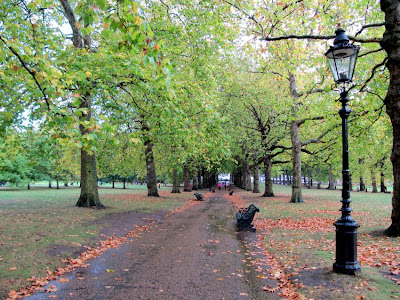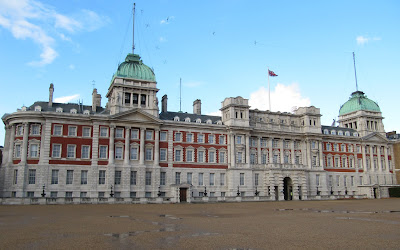 |
| St James's Park |
St James's Park and Green Park together with two other Royal Parks of London, Hyde Park and Kensington Gardens form an almost continuous green area in the centre of London.
In 1532, Henry VIII purchased an area of marshland from Eton College, through which the river Tyburn flowed. On James I's accession to the throne in 1603, he ordered the park drained and landscaped, and kept exotic animals in the park, including camels, crocodiles, and an elephant, as well as aviaries of exotic birds along the south.
During Charles II's exile in France under the Commonwealth of England, the young king was impressed by the elaborate gardens at French royal palaces, and on his ascension had the park redesigned in a more formal style. This included the creation of a canal. Charles II opened the park to the public, as well as using the area to entertain guests and mistresses.
 |
| St James's Park looking on Horse Guards Parade |
The 18th century saw further changes, including the reclamation of part of the canal for Horse Guards Parade and the 1761 purchase of Buckingham House (later Buckingham Palace) at the west end of the Mall, for the use of Queen Charlotte.
Further remodelling in 1826–7, commissioned by the Prince Regent (later George IV) and overseen by the architect John Nash, saw the straight canal's conversion to a more naturally-shaped lake, and formal avenues rerouted to romantic winding pathways.
 |
| Green Park |
Green Park is said to have originally been a swampy burial ground for lepers from the nearby hospital at St James's. It was first enclosed in the 16th century by Henry VIII, when it formed part of the estate of the Poulteney family. In 1668 an area of the Poulteney estate known as Sandpit Field was surrendered to Charles II, who made the bulk of the land into a Royal Park. The park consists entirely of wooded meadows.
At the time, the park was on the outskirts of London and remained an isolated area well into the 18th century, when it was known as a haunt of highwaymen and thieves. It was a popular place for ballooning attempts and public firework displays during the 18th and 19th centuries. The park was also known as a duelling ground.
St James's Park and Green Park are separated by Buckingham Palace and the Victoria Memorial.
 |
| Horse Guards Parade |
Horse Guards Parade was formerly the site of the Palace of Whitehall's tiltyard, where tournaments (including jousting) were held in the time of Henry VIII. It was also the scene of annual celebrations of the birthday of Queen Elizabeth I. The area has been used for a variety of reviews, parades and other ceremonies since the 17th century.
It was the Headquarters of the British Army. The Duke of Wellington was based in Horse Guards when he was Commander-in-Chief of the British Army.
 |
| Old Admiralty Building |
The Old Admiralty Building is the largest of the Admiralty Buildings. It was begun in the late 19th century and redesigned while the construction was in progress to accommodate the extra offices needed due to the naval arms race with the German Empire. It is a red brick building with white stone detailing in the Queen Anne style with French influences.
 |
| Cadiz Memorial |
The Cadiz Memorial is located in a corner of Horse Guards Parade. It is a French mortar mounted on a cast-iron dragon. It was a gift of the Spanish government to the Prince Regent in memory of the lifting of the siege of Cadiz following the defeat of the French forces near Salamanca in July 1812 by the Duke of Wellington's army.
 |
| Admiralty Arch |
Admiralty Arch is a large office building designed by Sir Aston Webb. It was commissioned by King Edward VII in memory of his mother Queen Victoria, although he did not live to see its completion in 1912.
 |
| Canada Gate |
Canada Gate, the entrance to Green Park nearest to Buckingham Palace, was presented to London by Canada when it was still a senior dominion of the British Empire, as part of a vast memorial scheme dedicated to Queen Victoria. Canada Gate was commissioned in 1905, along with the gates for Buckingham Palace and two other similar, but smaller gates presented by Australia and South Africa. It was finished and put in place in 1911.
 |
| Wellington Arch |
Wellington Arch, originally known as Green Park Arch, is located between Hyde Park Corner and Green Park. Wellington Arch and Marble Arch were planned in 1825 by George IV to commemorate Britain's victories in the Napoleonic Wars. Wellington Arch was built between 1826-1830 to a design by Decimus Burton. Much of the intended exterior ornamentation was omitted as a cost-saving exercise after the King's overspending on the refurbishment of Buckingham Palace, which was underway at the same time.
In 1846 the arch was selected as a location for a statue of Arthur Wellesley, 1st Duke of Wellington, soldier and Prime Minister. The Wellington Statue by Matthew Cotes Wyatt which eventually crowned the arch was 8.5m high, the largest equestrian figure ever made. It was so enormous that it generated considerable controversy and ridicule at the time. In 1912 the Wellington Statue was removed to Aldershot and a huge bronze quadriga designed by Adrian Jones took it's place. The sculpture depicts the angel of peace descending on the chariot of war.
The arch is hollow inside, and until the 1960s, it served as London's second smallest police station. The station was shut after an air vent for the Kensington Underpass was knocked through the arch's north side.
The Duke of Wellington Statue outside Apsley House is a bronze equestrian statue designed in 1888 by Joseph Edgar Boehm. The memorial is surrounded by 4 figures depicting four regiments he was associated with during his military career.
 |
| An impressive Victorian building which today houses the ESE |
Part I of this article series - Hyde Park and Kensington Gardens


No comments:
Post a Comment